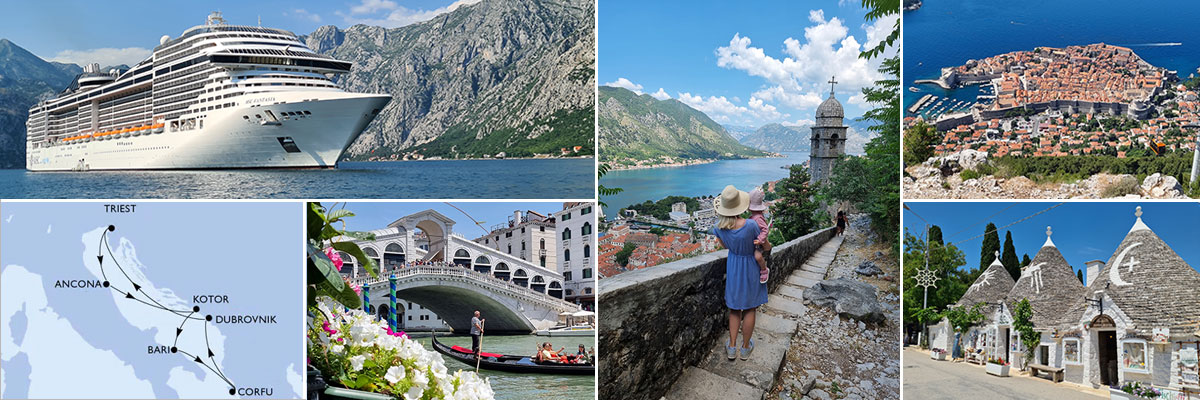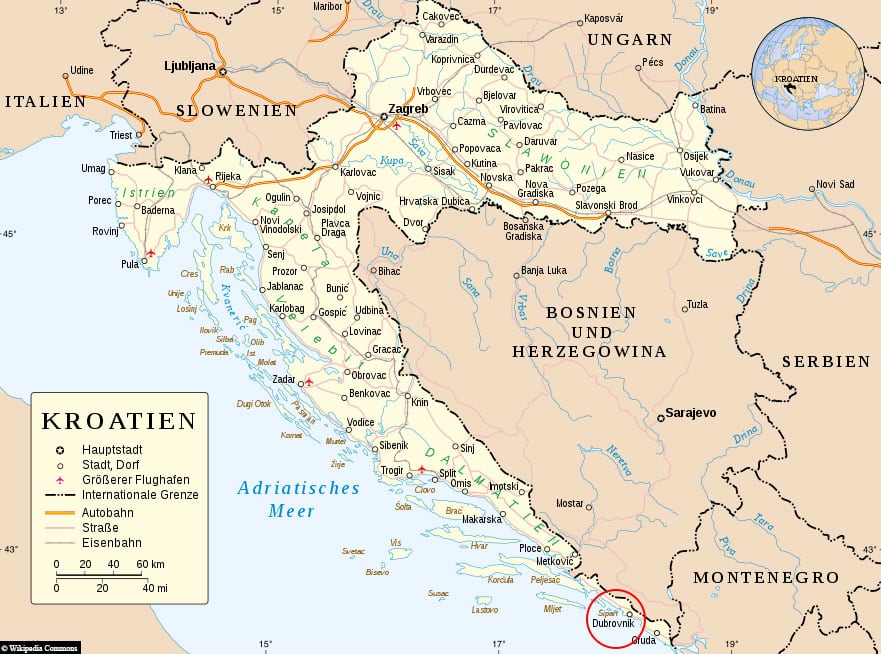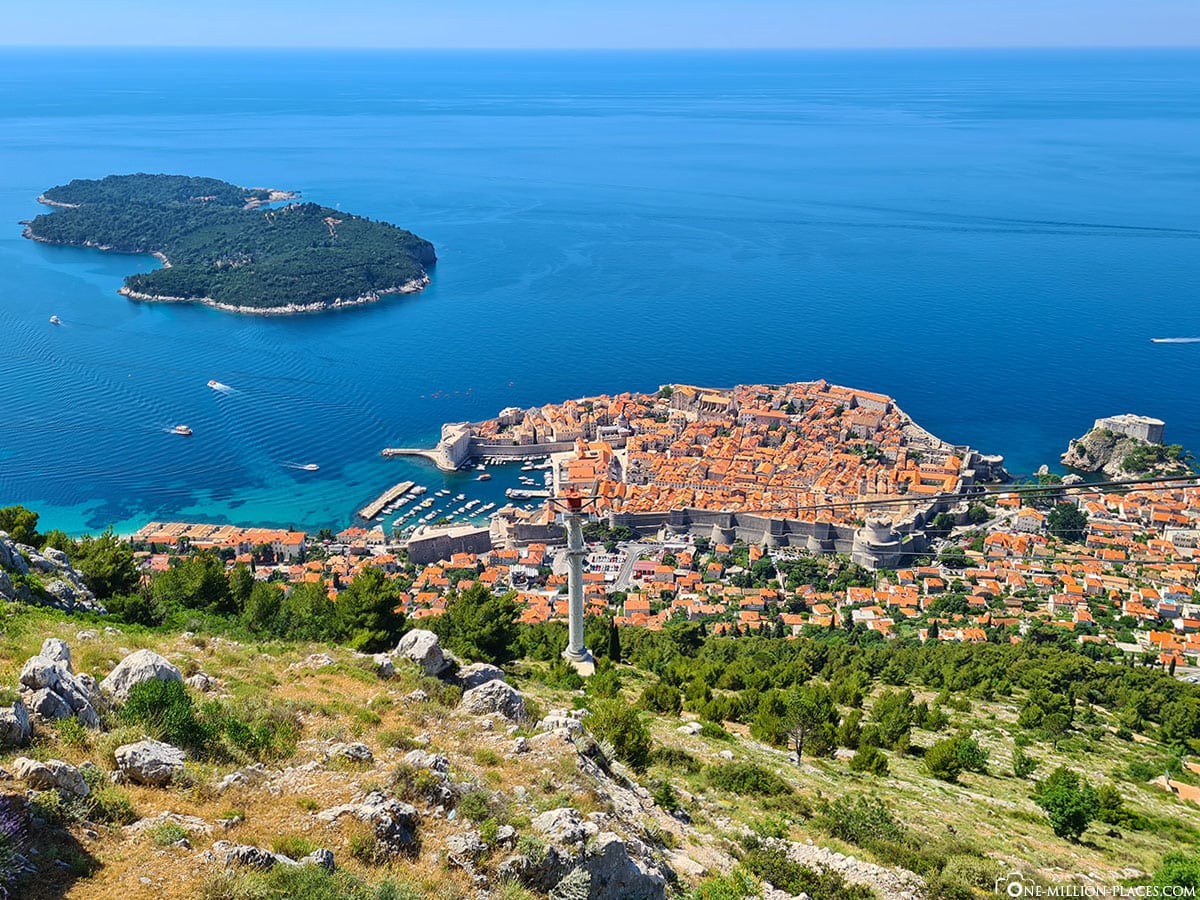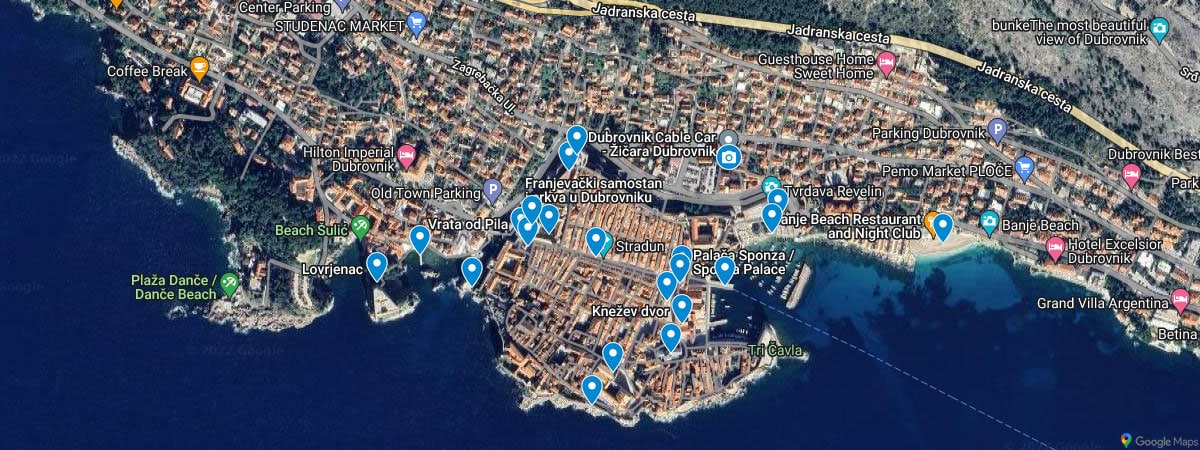A very special highlight of our 7-day cruise with MSC Cruises through the Adriatic Sea was the last stop: the visit to the UNESCO World Heritage city of Dubrovnik. The location of the medieval city directly on the sea, surrounded by massive fortress walls, towers and bastions, is an incredibly impressive and beautiful photo motif. Rightly, the city of Dubrovnik is one of the most popular and most visited destinations of cruises in the Mediterranean and throughout Europe.

Table of contents
Things to know about Dubrovnik (Croatia)
Dubrovnik is a city of about 43,000 inhabitants in southern Croatia on the Adriatic Sea and is one of the most beautiful cities in the Mediterranean. The city is best known for its nearly 2-kilometer-long city wall, one of the best-preserved medieval fortifications in all of Europe. It is not surprising that Dubrovnik with its impressive scenery has been the location of numerous films and series, such as the fantasy series Game of Thrones and the film Star Wars Episode VIII.
The old town, which has grown over the centuries, has been a UNESCO World Heritage Site in its entirety since 1979 and is home to amazingly well-preserved buildings and cultural monuments from the Middle Ages, the Baroque period and the Renaissance period. Among the most famous sights, besides the city walls, are the Cathedral of the Assumption of the Virgin Mary, the main promenade (“Stradun”), the Dominican Monastery, the Franciscan Monastery, the local mountain Brdo Srd, the Rector’s Palace, the Lovrijenac Fortress and a medieval pharmacy from 1317, which is one of the oldest pharmacies in Europe.
Interesting to know: Southern Dalmatia – the region around Dubrovnik – has been cut off from the rest of the country since Croatia gained independence in 1991 and is therefore an enclave. Between northern and southern Croatia, which belong to the EU, the non-EU country Bosnia-Herzegovina with its seaside resort Neum is located on a coastline of about 19 kilometers.
The fact that Dubrovnik is an enclave is difficult, especially for vacation and transit traffic, because you have to cross Bosnian-Herzegovinian territory for a few kilometers at the village of Neum, and for this you have to cross an external EU border twice with corresponding checks on people and customs. For this reason, the Pelješac Bridge was opened in 2022. The newly built bridge & road crosses a sea tongue of the Adriatic Sea in southern Croatia across the Peljesac Peninsula to Dubrovnik, bypassing the coastline of Bosnia and Herzegovina.
The cruise port in Dubrovnik
The cruise port of Dubrovnik is unfortunately located a little outside the old town, in the port of Gruž near the Franjo Tuđman Bridge (location in Google Maps). At the long pier several ships can dock one after the other. It is 3 kilometers to the old town and a walk takes about 45 minutes. On our day, 2 more ships had docked in Dubrovnik: one next to us in the cruise port and another in the roadstead, not far from the old city port. The ship at roadstead could then take its guests by tender boat directly to the old harbor in the old town, which is of course perfect.
The cheapest alternative to get from the cruise port to the old town is the public buses. The bus station is located to the right of the port exit. Here you will also find an exchange office (Croatia does not have EURO), an ATM and a ticket office. Lines 1a, 1b and 3 make regular trips to Brsalje Square with the Pile main entrance gate to the Old Town. What we found really good: directly in front of our ship were also several cabs that go directly to the central Brsalje square for a fixed price of 14 EUR. It is also possible to arrange city tours or panoramic tours with the cab drivers for 50 EUR. If one is here for example with several people in the car, this is really a great price!
Sights & Photo Spots in Dubrovnik
Most of Dubrovnik’s sights are located directly in the old town surrounded by the city walls. With the exception of limited delivery and resident traffic, the old town is completely car-free and, at around 1.3 square kilometers, is of manageable size.
The cable car to Mount Srd
Before we went to the old town, we wanted to have a look at Dubrovnik from above. And the best way to do that is from the almost 400 meter high local mountain Brdo Srd (Sergius Mountain).
The top of Brdo Srd can be reached in several ways: as a hike, by car or by cable car. We decided to take the cable car. From the central Brsalje square to the valley station of the Dubrovnik Cable Car you walk only about 10 minutes. Tickets can be purchased in advance on the official website and currently cost 200 HRK, which is the equivalent of about 26 EUR. It’s not exactly cheap, but the view is really worth it! The ride takes just over 3 minutes and from the panoramic platform you have a beautiful view of the old town of Dubrovnik, the massive city wall with its towers, the old harbor, the small offshore island of Lokrum and the blue sea. Only the pillars of the cable car have unfortunately somewhat disturbed the view of the city.
We spent about an hour up here before heading back to explore the old town.
The city wall of Dubrovnik
It is the landmark of Dubrovnik and the best preserved defensive medieval fortification system in Europe: the Dubrovnik City Wall.
The massive city wall is almost 2 kilometers long, up to 25 meters high and in some places up to 6 meters wide. And best of all, the city wall is completely walkable. Just like the entire old town, it is a UNESCO World Heritage Site. The walls were built for centuries and the first construction work began as early as the 8th century. The present wall was built mainly in the 13th century and was systematically modernized until the end of the 17th century. It consists of the main wall, sixteen towers, three fortifications, five bastions, two corner fortifications, several ditches and two drawbridges on the side of the city gates Pile and Ploče, which were raised at night to block access to the city.
The most beautiful activity in Dubrovik is certainly a walk on the 1,940 meters long city wall. The panoramic circular path leads up and down stairs, sometimes narrow or wide according to the diameter of the bulwark and always offers magnificent views of the old town and the sea. There are several entrances to the wall: the main entrance is at the beginning of the Stradun promenade at the Pile Gate. Another entrance is on the opposite side at the Ploče Gate. Opening hours vary between 8 a.m. and 7:30 p.m., depending on the season, and admission currently costs 250 HKR per person (33 EUR). For sightseeing in Dubrovnik, we had a Dubrovnik Card that gave us free use of public transportation for 24 hours, free admission to the city walls, and to numerous museums.
Our tip: Dubrovik is a destination for many cruises. On our day alone, 3 large ships docked in the harbor and roadstead and many thousands of people flocked to the city. Especially in the morning, we have therefore seen long lines and crowds on the city walls. Therefore, we had decided to start our tour late in the afternoon and that was really perfect! Despite 3 cruise ships, there was almost nothing going on on the city wall and we could walk the 2 kilometers quite relaxed with our little one.
By the way, the city wall is not suitable for strollers, i.e. we left our stroller at the ticket booth at the Ploče Gate and picked it up again after the tour. For the whole tour on the Dubrovnik Wall you should plan 1-2 hours, depending on how many breaks and photo stops you want to make 🙂
The 4 city gates
In Dubrovnik there are 4 city gates leading to the old town: the Pile Gate, the Ploče Gate, the Buža Gate and the Ponte Gate.
“ The Pile Gate: The main gate of Dubrovnik, the Pile Gate, is located on the west side and is a well-fortified complex consisting of an inner and an outer city gate. The outer city gate with a Renaissance arch was built in 1537. A stone bridge with a wooden drawbridge, which can be raised with the help of a winch and counterweights, leads to this gate across the moat, which is dry today.
“The Ploče Gate: On the eastern side of the city walls is the second important entrance to the city – the Ploče Gate. This gate, built in 1628, is protected by the detached Revelin Fortress, connected by a wooden drawbridge and a double stone bridge over a protective moat. Above the bridge, just like at the Pile Gate, there is a statue of St. Blasius, the patron saint of Dubrovnik.
“Buža Gate: Another entrance to the historical Old Town of Dubrovnik is the so-called Buža Gate. It is located on the north side of the land wall. This gate is relatively new compared to the other gates, as it was subsequently carved into the wall only in 1908, in order to give officers – during the Austrian rule over Dubrovnik – easier access to the tennis courts that had been built in the moat behind the city wall.
“The Ponte Gate: In the port area of the city there is also the Ponte Gate, built in 1476.
The city wall – The northern section
We started our tour of the city walls at the northeast corner at the Ploče Gate around 3:45 pm. There is a small inconspicuous entrance with a ticket booth and a few stairs leading up. We were able to leave our stroller, which we had with us to visit the old town, near the ticket booth. The path on the wall generally runs in a counterclockwise direction. So from here we first explored the northern part of the wall. The wall is very massive at this point and the path goes slightly uphill. The end of the northern section of the wall is formed by the large tower of the Minčeta fortress.
In this section of the wall you have a view of, among other things:
” The fortress Revelin
” The Ploče Gate
” The Dominican Monastery
” The Buža Gate
” The old town
” The Cathedral of Dubrovnik
” The fortress Minčeta
The city wall – The western section
The Minčeta Fortress is one of the four fortresses within the city walls of Dubrovnik and was built in the 14th century to protect the Pile Gate and the city center. The big tower of the fortress is the highest point of the old city wall. A narrow stone staircase leads to the top of the tower, from where you have a fantastic view over the city and the Adriatic Sea. From the Minčeta Fortress, the route then goes mostly downhill on the western part of the city wall towards the sea via the Pile Gate to the Bokar Fortress.
In this section of the wall you have a view of, among other things:
” The fortress Minčeta
” The city gate Pile
” The Franciscan Monastery
“The Stradun, the promenade of the old town
” The Onofrio Fountain
“The fortress Lovrijenac, located outside the old town.
The city wall – The southern section
This section of the wall runs along the rocky coast and offers especially beautiful views of the sea. The view of the old town, on the other hand, is often blocked by taller buildings, so that one tends to look at courtyards of adjacent houses. What we did like, however, is that there are some small kiosks and cafes in this section that are right on the wall and invite you to linger. The end of the southern section of the wall forms the 14. and 15th century fortress Sv. Ivan, which served primarily to defend the port of the city.
In this section of the wall you have a view of, among other things:
” The fortress Lovrijenac
” The fortress of St. Peter
” The fortress Sv. Ivan
” The sea
The city wall – The eastern section
The last part of our tour on the city walls led us mainly along the old harbor. In total, we have for our complete tour on the city wall incl. the many photo stops took about 1.5 hours. A good overview of the individual fortresses along the wall can be found here.
The old town of Dubrovnik
We started our tour of the old town of Dubrovnik at the Pile Gate. Here is the beginning of Stradun, the most important and largest promenade of the city with numerous street cafes, restaurants, souvenir stores and boutiques. An important building here is the Franciscan monastery with the oldest pharmacy in Europe. The pharmacy was founded by monks as early as 1317 and is still open today – as part of the Franciscan Museum. Opposite the monastery stands the large Onofrio Fountain, built in the 15th century to carry drinking water to the city via the city’s own aqueduct.
The Stradun leads to another landmark of Dubrovnik, the bell tower on Placa Luža. Here you can also find the Sponza Palace with the town archives and the baroque church of St. Blasius. From here you can get either to the old town harbor and the Dominican Church or south to the Rector’s Palace, the Baroque Church of Sv. Vlaho and the Dubrovnik Cathedral.
Overall, we really liked the old town of Dubrovnik, but everything looks a little too slick and almost “newly renovated”. In the meantime, there is hardly anything left to see of the destruction caused during the Yugoslavian war in the early 1990s, in which Dubrovnik was shelled massively for months. The limestone paving stones look as if they have been polished. However, this immaculate appearance of the streets and buildings also takes away a bit of the charm of an “old town”. For example, we liked our tour of Kotor a lot better.
But the tour of the city walls and the view of the city from the local mountain were an absolute highlight of our visit to Dubrovnik ❤
A map with all the sights in Dubrovnik
On the following map at Google MyMaps we have marked for you the most important sights & most beautiful photo spots in the old town of Dubrovnik. If one or the other point in the map is missing, then write us a message, then we take the point with pleasure still with addition 🙂
All travelogues of our cruise through the Adriatic Sea
We deliberately chose the 8-day cruise with MSC Cruises from Trieste, as it included some places that had been on our bucket list for a long time. In total, our trip took us through four countries: Italy, Montenegro, Greece and Croatia. We were able to experience six eventful and varied days on land: We started in Trieste, then continued to the port city of Ancona, through the breathtaking Bay of Kotor to Bari. The journey continued to the green island of Corfu and to medieval Dubrovnik with its impressive city walls, from where we returned to Trieste. Since our plane left from Venice, we were even able to make a small detour to the gondola city, which was another highlight of the trip. Cruise Day 1 » MSC Cruises – Cruise with MSC Fantasia in the Adriatic Sea
Cruise Day 1 » MSC Cruises – Cruise with MSC Fantasia in the Adriatic SeaCruise Day 1 » Trieste – Sights & the best Photo Spots in one day (Italy)
Cruise Day 2 » Ancona – The most famous sights in the old town (Italy)
Cruise Day 3 » Kotor – Bay, old town and fortification (Montenegro)
Cruise Day 4 » Bari – Top sights & photo spots in the old town (Italy)
Cruise Day 4 » Alberobello – A day trip from Bari to the Trulli houses (Italy)
Cruise Day 5 » Corfu – Discover the island in one day (Greece)
Cruise Day 6 » Dubrovnik – Top sights & photo spots in one day (Croatia)
Cruise Day 7 » Day at Sea
Cruise Day 8 » Venice - The most famous sights in just one day (Italy)





